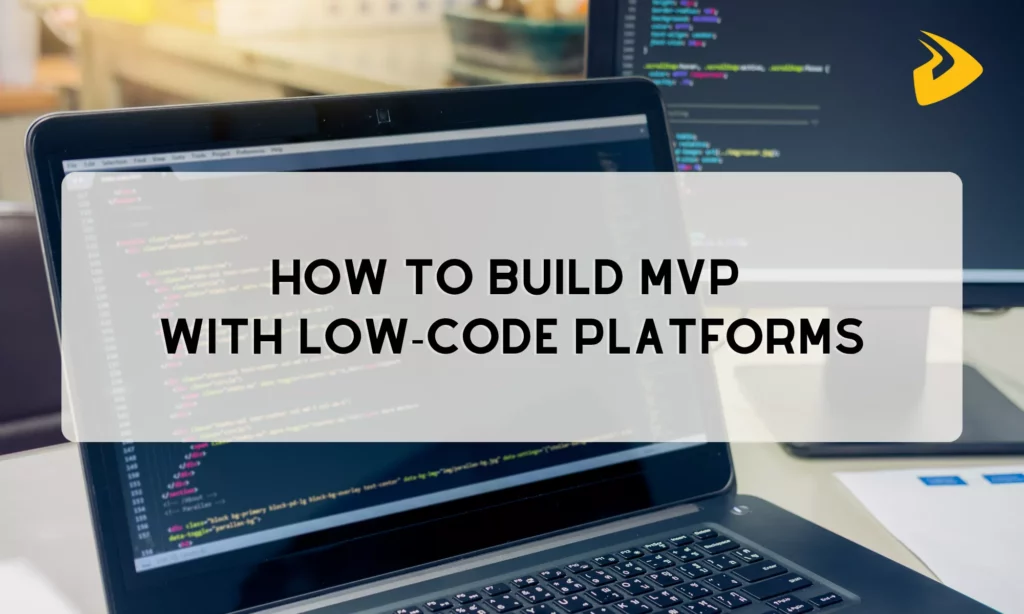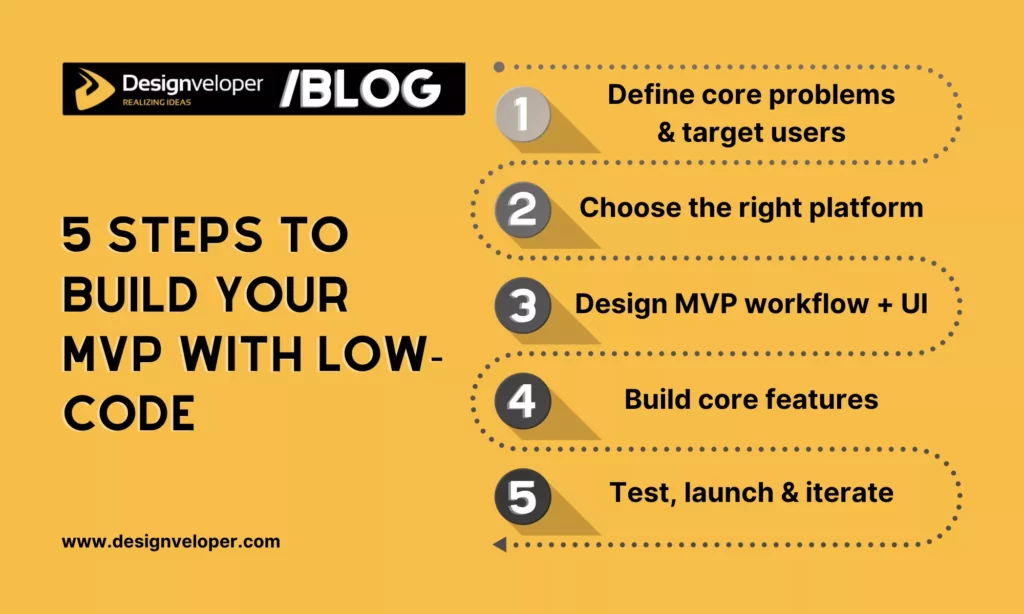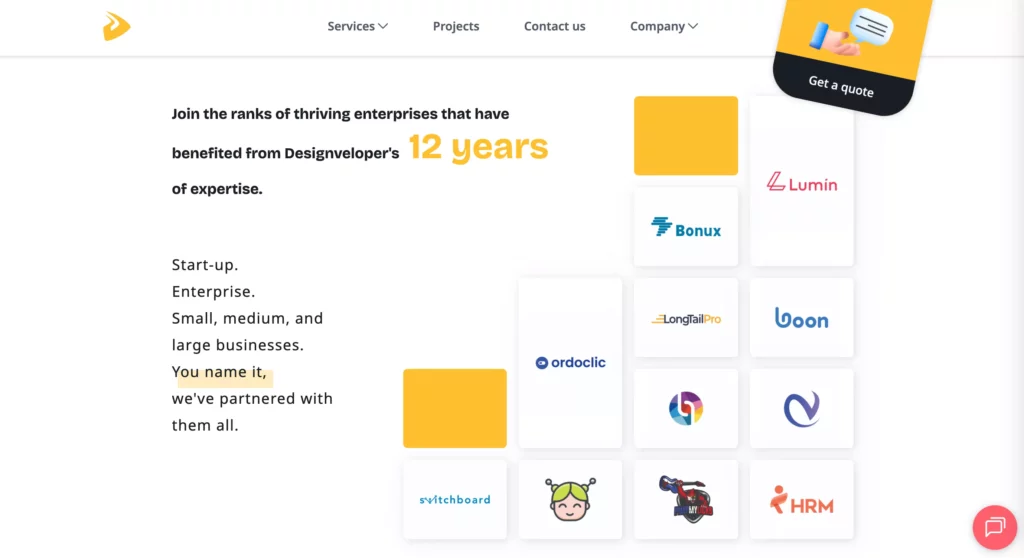Before you can paint a masterpiece, you must draw your idea on paper. Likewise, you have to make an MVP (Minimum Viable Product) before building the product.
There are multiple ways to get an MVP on the board, one of which is by leveraging low-code platforms. So why should you choose low-code platforms for MVP development and, how to build it effectively?
In this blog post, we’ll show how to develop a MVP with low-code, even when you’re a beginner in this realm. Keep reading!

Why Choose Low-Code for Your MVP?
MVPs matter because they help your business validate your app concept, earn stakeholder/investor buy-in, and display your market intelligence.
If you rush to the market with a complete product without MVPs, you’ll likely fail to meet market needs. Through MVPs, you can test how legitimate users react to your solution and collect feedback to improve it.
For this reason, MVPs are becoming increasingly important, with an estimated value of $315 million in 2025.
In recent years, low-code has been the top option for those who want to build MVPs. Below are several benefits of this approach:
Low-code platforms usually cost less than bringing on a full development team.
Traditional software projects drag on. You start with an idea, then move through planning, coding, testing, and fixing bugs; but this process may eat up months.
With low-code, you skip a lot of that. Projects that used to take months now wrap up in just a few weeks. You get these visual editors and easy drag-and-drop tools, so making changes or fixing things based on user feedback feels pretty straightforward.
Low-code platforms can save 50-70% development costs, which involve significant development time and effort.
Without a large team of full-stack developers, QA testers, and other specialists, you can organize a fusion team of business staff and developers.
Of which, business users (e.g., product owners or marketers) are well-trained to follow low-code guidelines and build an MVP with the support of low-code platforms. Meanwhile, developers will supervise the whole work, build highly customized features, and ensure security and compliance.
- Easy Iteration and Scalability
Low-code platforms offer ready-made tools to add new features quickly. Further, various platforms support scaling your apps to the enterprise level after MVPs are launched and prove successful.
5 Steps to Build Your MVP with Low-Code

So, do you want to create your MVP with low-code platforms but don’t know where to start? Don’t worry! Follow these steps below and start building your MVP:
Step 1: Define Your Core Problem and Target Users
When building an MVP, don’t think about killer features that your competitors may ignore in their solutions, and that your app needs to interest users.
Nope, these features only attract users for a short time if they don’t genuinely cater to the demands of your target audience or resolve their pain points successfully.
Therefore, first off, you should identify the core problem and target users of your MVP.
- Does your MVP target sales reps, young people who want to keep fit, internal staff, or anyone else?
- What’s their personal and professional background (e.g., gender, age, or income)?
- What are the pain points they are facing? Is that problem about collecting customer data from scattered sources, following diets strictly, or onboarding new employees?
- Are your users doing things in their daily routines that actually get in the way of your MVP’s success? Say you roll out a fitness app, but your users keep forgetting to log their meals. That habit alone makes it tough for them to get real value from what you’ve built.
When you dig into questions like these, you run deeper market research and start shaping a real customer persona. You’ll see who your ideal users are, what problems they struggle with, and what your app has to do to help them out.
Step 2: Choose the Right Low-Code Platform
You’ve got your target users and you know their pain points. Time to choose the right low-code platform for your project.
These days, low-code platforms come loaded with visual tools, plug-and-play components, AI features, and automated workflows. Building an MVP? Way easier now. Still, not every platform is perfect for every job.
Pick one that matches your users’ needs and your project’s requirements—think about the scope, your budget, all of it. Try to get a free trial or at least a demo so you can see if it fits how you work and if it actually delivers.
Not sure where to start? Here’s our suggestion:
- Bubble / Adalo: for web & mobile MVPs
- Bubble allows startups and even developers to build interactive web apps without coding. It has highly customizable features and strong integration with external APIs. But it may be hard for beginners to use and perform poorly on very complex solutions.
- Adalo excels at creating mobile-focused MVPs across platforms. But its customization and advanced functionalities are limited.
- OutSystems / Mendix: for enterprise-grade solutions
- OutSystems fits enterprise-grade and large-scale MVPs that require strong backend integrations. But it comes with high costs and a steeper learning curve.
- Mendix works best for modernizing legacy systems and automating business functions at the enterprise level. However, it has a steep learning curve and a complex interface.
- Power Apps / Retool: for internal and B2B solutions
- Microsoft Power Apps helps build internal and business MVPs, especially those linking with Microsoft products. However, it struggles to handle large datasets.
- Retool is ideal for building internal apps and automated workflows in finance, logistics, and consumer goods. But it has a significant learning curve, especially for those without coding knowledge.
Step 3: Design Your MVP Workflow and User Interface
Now it’s time to map out your MVP’s workflow and user interface.
Grab one of those visual process builders on your low-code platform and start sketching. If you’ve already got designs in Figma or Sketch, just pull them in—most platforms make that easy.
Really, mapping out your workflow is key. It shows you what users actually experience, from the moment they open your app to when they finish a task.
Most modern low-code platforms make this part pretty painless. You get drag-and-drop editors, templates, and a bunch of tools to play with layouts, colors, and branding.
You can tweak everything to fit your product’s style, and you don’t need to mess with backend code. Just build, preview, and see your UI come to life right away.
Step 4: Build Core Features Using Low-Code Tools
With your user journey mapped, you’re ready to build out the core features that make your MVP work.
Low-code platforms give you visual logic editors, prebuilt integrations, and automation tools—so you can add the essentials without getting stuck in technical weeds.
You decide exactly how the app responds when people use it. Say you need a signup form: normally, a developer would have to write backend code to check the data, save it, and send a response. With low-code, you just set this up visually, no fuss.
You can also hook your app up to databases, other systems, and external services using built-in or custom connectors.
And when you want to automate boring stuff, like sending notifications for employee leave requests, you set up triggers and workflows.
All of this comes together to make your MVP actually useful, fast.
Step 5: Test, Launch, and Iterate Fast
Even with low-code tools, you still need to make sure your MVP actually works. Most platforms come with built-in testing and preview features, so you can see how everything runs before you go live.
You get to try out the user interface, mess with workflows, check data connections, and see how it all performs. Catching bugs or clunky bits early saves you headaches later, especially when it comes to user experience and making sure everything connects the way it should.
Once your MVP clears these basic tests, it’s time to show it to real users and hear what they think.
Launching is pretty flexible now. These platforms let you deploy on their own cloud, on big services like AWS or Google Cloud, on your own servers, or even a mix of all that. You don’t need to jump through a bunch of manual setup hoops, either.
When users start giving feedback, you can jump right in, improve what’s not working, or fix any problems. The visual editors make changes quick and painless, so updating your MVP becomes a lot less of a hassle.
How Much Does It Cost to Build a Low-Code MVP?

It’s quite hard to estimate an accurate figure for building an MVP with low-code. This is because the cost varies depending on your team’s technical skill, project complexity, and other requirements (e.g., for scalability).
Normally, if you build an MVP using traditional software development, a simple MVP may cost $5,000 – $15,000 and last 2-4 weeks. Meanwhile, a complex MVP can take at least $50,000.
So, does this cost decrease when you create a low-code MVP? The answer depends on various factors.
Suppose your team is well-trained and has enough IT knowledge to build an internal app that doesn’t require high customization, complex integrations, or superior security. So, well, low-code platforms may cost you less for MVP development.
However, the cost will increase when your MVP scales, when advanced integrations or infrastructure are required, or when your staff has to build something beyond their technical knowledge.
Remember that the cost of building a low-code MVP does not only revolve around licensing fees but also extends to hidden fees. These fees include premium features, custom API integrations, targeted training for citizen developers, platform lock-in, and more.
Read more about these costs in our blog post: Low-Code Development Cost: Does It Really Save Money?
Understanding these fees will help you balance low-code usage to reduce the development cost and budget your MVP development more effectively.
Common Pitfalls When Building a Low-Code MVP
Low-code platforms prove useful in helping you build an MVP to validate your app concept, launch fast, and reduce costs. However, many people still fail to create a low-code MVP successfully due to some common mistakes as follows:
- Over-customizing too early
Many teams often try to impress their target users with an app that contains too many customized features.
This is a big mistake, as the main goal of an MVP is to test your core value with the simplest version instead of a possibly complete app.
So, just focus on the most critical features that directly solve the main pain points of your users.
- Picking the wrong platform
Not all low-code platforms are created equal.
If you pick the wrong one, you may not customize things the way you want or struggle to connect to your current systems.
So, take the time to compare your options and pick a platform that fits your long-term plans, not just what looks good right now.
- Skipping early validation
You might feel confident that your MVP covers everything users want, but honestly, you can’t trust your gut on this.
Don’t wait until you’ve polished every feature before you let real people try it out. Ship early versions to a handful of users, watch how they use it, and listen to what they say about it.
Getting this feedback early keeps you from wasting time building stuff nobody wants.
Another big mistake is just focusing on licensing fees and overlooking hidden costs, like integration, hosting, and vendor lock-in.
Forget to estimate these fees in your development budget, and you will face substantially increased costs.
Therefore, you should calculate your initial build costs and ongoing maintenance fees to balance your budget effectively, even when your usage increases.
Building a Low-Code MVP with Designveloper

Even when you have a low-code platform as a big help for MVP development, you still need professional developers to ensure everything is performant, secure, and compliant. And Designveloper is willing to help you build a low-code MVP effectively with our deep expertise and hands-on experience.
Why us?
- Bring your idea to life faster
As the leading software developer in Vietnam, our talented developers accompany you from ideation to deployment and maintenance. Following flexible Agile approaches, we help you identify the core features that truly address your main problems and deliver real value to end users.
- Choose the right tools aligned with your growth
We blend the right tools to make your MVP’s success. By analyzing your goals, technical needs, and scalability plans, we suggest the best fit for scalability later.
We help you design intuitive, modern interfaces and build core features using low-code platforms and custom code. We follow software development and design principles to make your MVP fully functional and match your brand.
Our team also performs testing to identify issues and make necessary adjustments, helping your business refine your product based on real-world insights. We also stay by your side to scale your MVP by expanding features, upgrading security, and integrating new systems.
Contact us now and receive our consultation to bring your idea to life!


